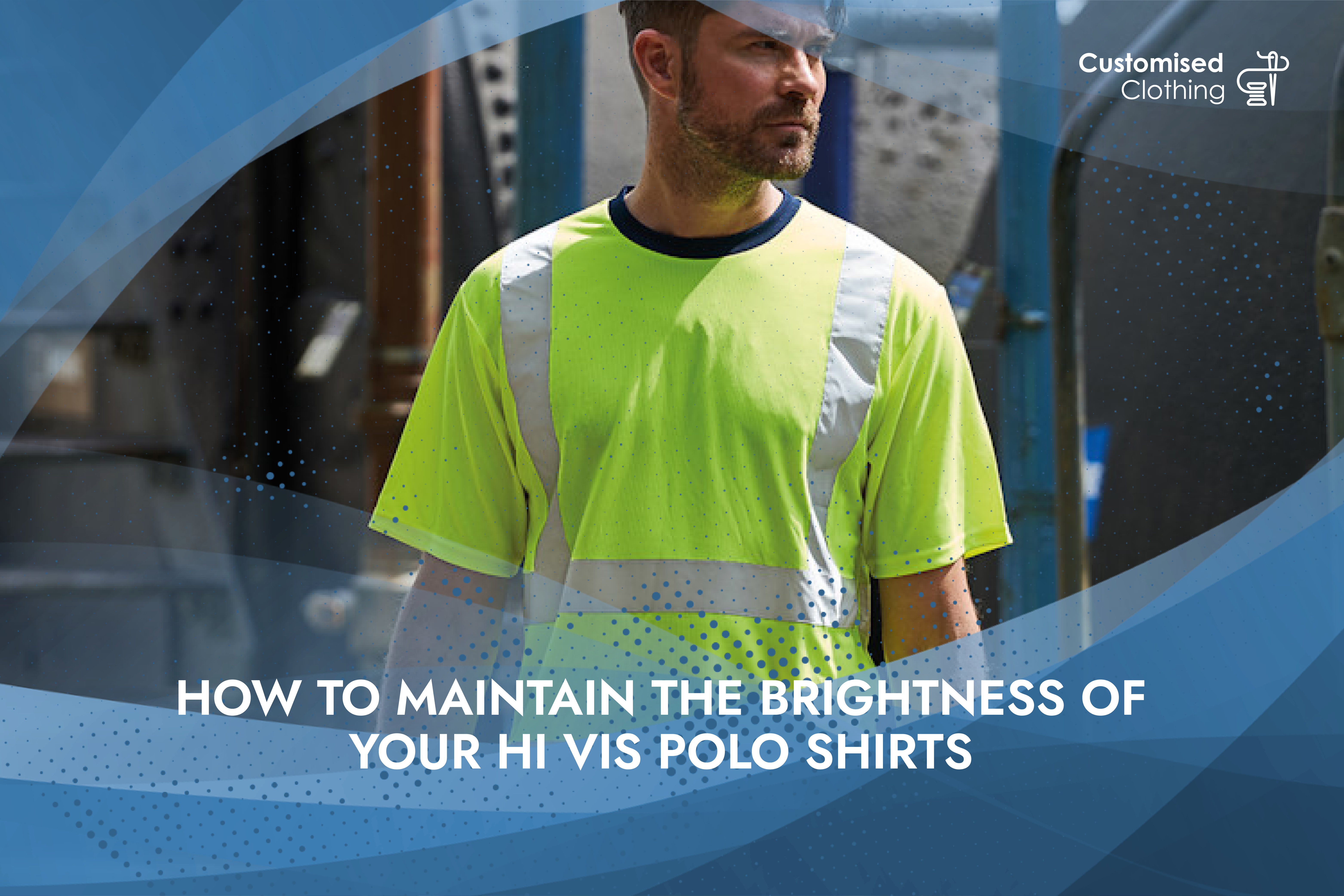In several industries, like construction and roadside labour, high-visibility (hi-vis) polo shirts are must-have clothing for worker safety. These shirts lower the risk of accidents by keeping workers visible in low light, all thanks to their reflective materials and vibrant design. But it can be difficult to keep these shirts bright and shiny, especially after repeated washings and wear. You will receive advice and best practices from this in-depth blog to guarantee that your hi-vis polo shirts stay visible and functional for the duration of their useful life.
Prior to discussing maintenance advice, it’s important to comprehend what makes hi vis polo shirts unique. Fluorescent hues like lime green, orange, and yellow are common for these shirts, and reflective strips are frequently added for added flair. Special dyes and materials that absorb and reflect more light than ordinary fabrics are used to produce the brightness.


Materials Employed
The majority of hi-vis polo shirts are composed of polyester or a polyester blend. This particular cloth was selected due to its strength, capacity to absorb brilliant dyes, and ability to wick away moisture. Typically, glass beads or micro prismatic technologies are used to create reflective strips, which are intended to return light to its source.
How to Clean and Wash Your Hi-Vis Polo Shirts?
The washing procedure is one of the main elements that influences the brightness of hi-vis polo shirts. The colours may fade, and the reflective strips may become less effective if they are not washed properly. The following are thorough instructions for cleaning your polo hi-vis shirts:
Preparing for Pre-Wash
Check the clothes for excessive soiling or stains before washing. Use a stain remover appropriate for synthetic textiles or a mild detergent to prevent stains. Bleach and other strong chemicals should not be used since they might harm the cloth and lessen its brightness.
Selecting the Proper Detergent
Make use of a gentle detergent made especially for synthetic materials. Steer clear of detergents containing bleach, optical brighteners, or fabric softeners, as they have the potential to deteriorate reflecting fabrics and fluorescent dyes. Seek for detergents with the labels “gentle” or “colour-safe.”
Settings for the Washing Machine
Use cold or barely warm water and put your washing machine on a moderate cycle. The colours may fade more quickly in hot water. The dye and the fluorescent strips are better preserved when washed in cold water. Make sure the machine is well-rested, as this could lead to excessive friction and t-shirt wear.
Hand Washing Properly
If you would instead wash by hand, put some cold water in a sink and some mild detergent in it. The polo hi-vis shirts should be submerged after gently stirring the water to produce suds. To clean the fabric, gently massage it together, being very careful around any stained spots. Rinse well with cold water to get rid of all of the detergent.
Drying
The ideal method for hi-vis polo shirts is air drying. Either put them flat on a spotless surface away from the sun or hang them on a clothesline. Extended exposure to sunlight may result in colour fading. If you must use a dryer, use the lowest heat setting and take the clothes out to let them air dry while they’re still slightly moist.
How to Store Hi-Vis Polo Shirts?
To keep your hi-vis customisable clothing bright and long-lasting, proper storage is essential. Here are some pointers for storing:
Vacuum and Dry
Hi-vis polo shirts should always be stored after they are scorched and clean. Stowing wet or unclean clothing can cause the fabric to deteriorate, smell, and grow mildew.
A Dark, Cool Place
The shirts should be kept out of direct sunshine and heat sources in a cold, dark environment. Extended exposure to ultraviolet radiation may result in colour fading and reduced efficacy of the reflective strips.
Comparing Hanging and Folding
To keep the shirts from creasing and to preserve their shape, hang them. Place them neatly folded in a drawer or on a shelf if you are unable to hang them. The reflective strips may get permanently creased if heavy objects are piled on top of them.
Prevent Common Mistakes
Avoid these frequent blunders to make sure your hi-vis polo shirts stay bright and functional:
Applying Fabric Softeners or Bleach
While fabric softeners might leave a residue that lessens the efficiency of the reflective strips, bleach can break down the fibres and destroy the luminous dyes. Steer clear of harsh chemicals and stick to mild detergents.
Ironing
Excessive heat might harm the reflective strips as well as the fabric. If ironing is required, protect the fabric by using a low heat setting and sandwiching a cloth between the iron and the shirt.
Using Regular Laundry for Washing
Regular laundry detergent can lead to lint transfer and friction damage when washing hi-vis polo shirts.
Regular Examinations and Replacements
The usefulness of hi-vis polo shirts ages with time and have a limited shelf life. Safety depends on prompt replacements and routine inspections.
Visual Examining
Check your hi-vis polo shirts frequently for wear and tear indicators like peeling, fraying, or fading reflective strips. Pay particular attention to the shoulder and side regions that are subjected to the greatest amount of friction.
Test of Reflective Materials
In a dimly lit area, test the reflective strips’ efficacy with a flashlight or your car’s headlights. The strips ought to have a strong light reflection. It’s time to replace the shirt if it starts to seem uneven or dull.



Few Methods of Customising the Hi-Vis Polo Shirts?
Printing Straight to Garment (DTG)
Direct to garment prints images directly into cloth using specialist inkjet technology. It works well with full-colour, highly detailed designs.
Advantages
High Detail: Great for designs that are complex and multicoloured.
Soft Feel: The fabric gets a smooth finish as a result of the ink absorbing into it.
No Order Minimum: Economical for one-off creations or tiny quantities.
Cons:
Durability: It might not hold up as well as embroidery or screen printing.
Cost: For large orders, the cost per unit is higher.
Reflective Logos and Text
Adding reflective logos and text improves the customisation’s visibility and blends in well with the shirts’ hi-vis feature.
Advantages:
Improved Visibility: By reflecting light, this increases safety.
Distinctive Look: Exceptional personalisation in line with security measures.
Cons:
Cost: The cost of reflective materials may be higher.
Limited Design Options: Extensive designs might not be supported.
Heat Transfer Vinyl(HTV)
Using heat press technology, vinyl sheets are cut into the desired designs for HTV shirts. Both straightforward and complex designs can be created using this technique.
Advantages:
Versatile: Enables intricate, multicoloured designs.
Quick Turnaround: Produced more quickly than with screen printing.
Robust: Able to withstand regular wear and washing.
Cons:
Feel: Compared to other techniques, it could feel stiffer or heavier.
Not the Best for Large Orders: It can be more expensive in larger volumes.
Using a Screen Printing Method
One of the most widely used techniques for personalising hi-vis polo shirts is screen printing t shirts online. Using this technique, layers of ink are applied to the shirt’s surface by making a stencil, also known as a screen.
Advantages:
Sturdy: Screen prints are resistant to abrasions and repeated washings.
Vibrant Colours: Bright and striking designs are guaranteed by premium inks.
Cheap for Large Orders: Because the cost per unit is lower, this option is best for larger orders.
Cons:
Setup Time: Needs the creation of screens for every colour, which can take a while.
Restricted Colours: Because of the layering process, this works best for designs with fewer colours.
Conclusion
Sustaining the luminosity of your hi-vis polo shirts is crucial to guaranteeing safety and visibility in dangerous situations. Increase the usefulness and longevity of your hi-vis clothes by looking through this blog, which includes using gentle detergents, staying away from strong chemicals, and storing the shirts correctly. Maintaining the best possible condition for your safety equipment can also be achieved through timely replacements and routine inspections. Your hi-vis polo shirts will keep providing the protection and visibility you require for work as long as they are correctly cared for.


